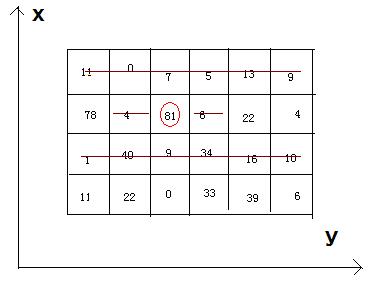Beans
Time Limit: 2000/1000 MS (Java/Others) Memory Limit: 32768/32768 K (Java/Others)Total Submission(s): 5572 Accepted Submission(s): 2527
Problem Description
Bean-eating is an interesting game, everyone owns an M*N matrix, which is filled with different qualities beans. Meantime, there is only one bean in any 1*1 grid. Now you want to eat the beans and collect the qualities, but everyone must obey by the following rules: if you eat the bean at the coordinate(x, y), you can’t eat the beans anyway at the coordinates listed (if exiting): (x, y-1), (x, y+1), and the both rows whose abscissas are x-1 and x+1.

Now, how much qualities can you eat and then get ?

Now, how much qualities can you eat and then get ?
Input
There are a few cases. In each case, there are two integer M (row number) and N (column number). The next M lines each contain N integers, representing the qualities of the beans. We can make sure that the quality of bean isn't beyond 1000, and 1<=M*N<=200000.
Output
For each case, you just output the MAX qualities you can eat and then get.
Sample Input
4 6
11 0 7 5 13 9
78 4 81 6 22 4
1 40 9 34 16 10
11 22 0 33 39 6
Sample Output
242
这道题的思路是先求单独一行的最大不连续子序列,然后在把每一行的最大不连续子序列和看成一个元素,进而再求所有行最大不连续子序列和。
#include<stdio.h>
#include<string.h>
#include<algorithm>
using namespace std;
int dpx[200005];//dpx[i]:当前这一行的前i列的最大不连续子序列和
int dpy[200005];//dpy[i]:前i行的最大不连续子序列和,名称dpy,不太准确
int main()
{
int n,m;
while(~scanf("%d%d",&n,&m))
{
int num;
memset(dpx,0,sizeof(dpx));
memset(dpy,0,sizeof(dpy));
for(int i=2;i<=n+1;i++)
{
for(int j=2;j<=m+1;j++)
{
scanf("%d",&num);
//当前(i,j)有两个状态;不选则(i,j-1),选则(i,j-2)+(i,j);
dpx[j]=max(dpx[j-1],dpx[j-2]+num);
}
//求整体,对每一行也是都有两个状态,要么整行不选,要么选
//选的话加上当前整行的最大不连续子序列和dpx[m+1]
dpy[i]=max(dpy[i-1],dpy[i-2]+dpx[m+1]);
}
printf("%d\n",dpy[n+1]);
}
return 0;
}